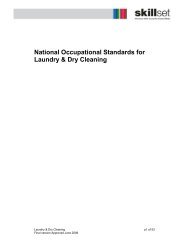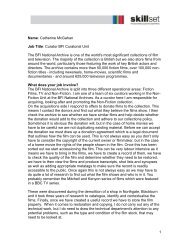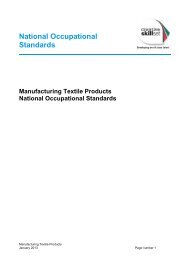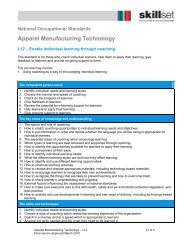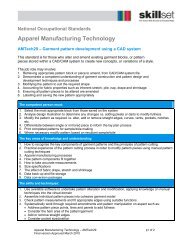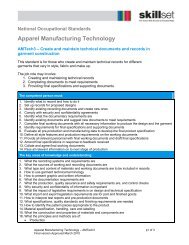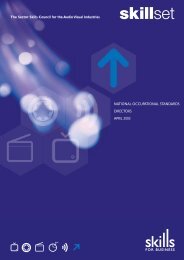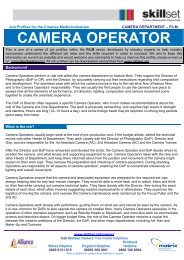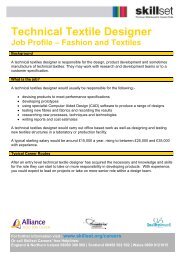TEX30 Develop designs for textile products - Skillset
TEX30 Develop designs for textile products - Skillset
TEX30 Develop designs for textile products - Skillset
You also want an ePaper? Increase the reach of your titles
YUMPU automatically turns print PDFs into web optimized ePapers that Google loves.
National Occupational Standards<br />
Manufacturing Textile Products<br />
<strong>TEX30</strong> – <strong>Develop</strong> <strong>designs</strong> <strong>for</strong> <strong>textile</strong> <strong>products</strong><br />
This standard is <strong>for</strong> those who develop <strong>designs</strong> <strong>for</strong> <strong>textile</strong> <strong>products</strong> from initial conception to final<br />
sample; interpret the customer’s requirements; work to a design brief; produce a visual<br />
interpretation of the design and adapt this to meet customer requirements until approval is given;<br />
agree cost-effective methods of producing the first sample; produce accurate in<strong>for</strong>mation,<br />
samples and specifications as required.<br />
The job role may involve:<br />
1. Identifying customer requirements<br />
2. <strong>Develop</strong>ing the design sample<br />
3. Finalising the design<br />
The competent person must:<br />
1. Identify and assess customer requirements<br />
2. Research alternatives <strong>for</strong> realising customer requirements<br />
3. Select suitable materials and components<br />
4. <strong>Develop</strong> the initial design concept<br />
5. Consider cost constraints on the design<br />
6. Produce a visual interpretation of the design<br />
7. Agree a cost-effective method of producing the design sample<br />
8. Seek customer approval <strong>for</strong> visual interpretation of the design<br />
9. Produce in<strong>for</strong>mation, samples and specifications <strong>for</strong> the design<br />
10. Record the design development process<br />
The key areas of knowledge and understanding:<br />
Interpretation of customer requirements<br />
1. How to research design trends, competitor markets and market developments<br />
2. Sources of records, archives and sample libraries and how to make effective use of them<br />
3. How to interpret a design brief and customer requirements<br />
4. Relevant data and how to use them<br />
5. Sources of in<strong>for</strong>mation regarding legislative requirements<br />
<strong>Develop</strong>ing a design concept<br />
6. Production processes and machine capabilities<br />
7. Materials and their characteristics<br />
8. Customer pricing structures and policies<br />
9. How to establish the fitness <strong>for</strong> purpose of the <strong>textile</strong> product<br />
10. The construction of <strong>textile</strong> <strong>products</strong><br />
11. Types of visual interpretation<br />
12. How to maintain records<br />
13. Customer sampling procedures<br />
14. Customer approval procedures<br />
The skills and techniques:<br />
1. Identifying customer requirements and assessing how they can be met<br />
Manufacturing Textile Products – <strong>TEX30</strong> p1 of 2<br />
Final version Approved March 2010
2. Conducting research and gather relevant in<strong>for</strong>mation to enable customer requirements to be met<br />
3. Interpreting and incorporating customer requirements into the initial design and selecting an appropriate<br />
method to visually present it<br />
4. Producing a visual interpretation of the design <strong>for</strong> presentation to the customer and obtaining customer<br />
approval to proceed with development<br />
5. Gathering and collating relevant in<strong>for</strong>mation <strong>for</strong> design development from appropriate people<br />
6. Recording customer requirements accurately and fully<br />
7. Identifying and selecting appropriate materials and components to meet requirements<br />
8. Providing in<strong>for</strong>mation on sources of supply of materials and components to the appropriate people<br />
9. <strong>Develop</strong>ing <strong>designs</strong> which take into account customer cost constraints<br />
10. Providing accurate in<strong>for</strong>mation and prototype design specification <strong>for</strong> sample production<br />
11. Ensuring materials and components to be used in sample development are available<br />
12. Monitoring the development of samples and modifying design specifications to meet requirements<br />
13. Ensuring the sample meets the specification requirements and approving it<br />
14. Identifying the approved sample and storing it in the agreed place<br />
15. Contributing to customer approval procedures and in<strong>for</strong>ming relevant people when the design is<br />
approved<br />
16. Ensuring samples are tested to ensure that they meet customer requirements<br />
17. Making sure that approved samples and final specifications are complete, accurately identified and<br />
available to the appropriate people<br />
18. Making sure that customer sampling requirements are met within agreed timescales<br />
19. Completing and safely storing specifications and sample <strong>products</strong> in the agreed place in accordance<br />
with approved procedures<br />
Regulations, rules and guidelines:<br />
1. The organisation’s rules, codes, guidelines and standards<br />
2. Limits of personal responsibility<br />
3. Reporting procedures<br />
4. Equipment operating procedures<br />
5. Responsibilities under the Health & Safety at Work Act<br />
6. Manufacturers instructions<br />
Workplace skills:<br />
1. Receive work instructions and specifications and interpret them accurately<br />
2. How to make use of the in<strong>for</strong>mation detailed in specifications and instructions<br />
3. Report problems outside area of responsibility to the appropriate person<br />
4. Complete relevant documentation accurately and promptly and keep records in the agreed place and / or<br />
pass it on to the appropriate people<br />
5. Roles and responsibilities of self and others in the design process<br />
6. Limits of personal responsibility and lines of communication<br />
7. Communicate effectively<br />
8. Complete <strong>for</strong>ms, reports and other documentation following organisational guidelines<br />
Manufacturing Textile Products – <strong>TEX30</strong> p2 of 2<br />
Final version Approved March 2010



